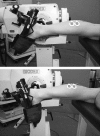The Effects of Sex, Joint Angle, and the Gastrocnemius Muscle on Passive Ankle Joint Complex Stiffness
- PMID: 12937478
- PMCID: PMC155431
The Effects of Sex, Joint Angle, and the Gastrocnemius Muscle on Passive Ankle Joint Complex Stiffness
Abstract
OBJECTIVE: To assess the effects of sex, joint angle, and the gastrocnemius muscle on passive ankle joint complex stiffness (JCS). DESIGN AND SETTING: A repeated-measures design was employed using sex as a between-subjects factor and joint angle and inclusion of the gastrocnemius muscle as within-subject factors. All testing was conducted in a neuromuscular research laboratory. SUBJECTS: Twelve female and 12 male healthy, physically active subjects between the ages of 18 and 30 years volunteered for participation in this study. The dominant leg was used for testing. No subjects had a history of lower extremity musculoskeletal injury or circulatory or neurologic disorders. MEASUREMENTS: We determined passive ankle JCS by measuring resistance to passive dorsiflexion (5 degrees.s(-1)) from 23 degrees plantar flexion (PF) to 13 degrees dorsiflexion (DF). Angular position and torque data were collected from a dynamometer under 2 conditions designed to include or reduce the contribution of the gastrocnemius muscle. Separate fourth-order polynomial equations relating angular position and torque were constructed for each trial. Stiffness values (Nm.degree(-1)) were calculated at 10 degrees PF, neutral (NE), and 10 degrees DF using the slope of the line at each respective position. RESULTS: Significant condition-by-position and sex-by-position interactions and significant main effects for sex, position, and condition were revealed by a 3-way (sex-by-position, condition-by-position) analysis of variance. Post hoc analyses of the condition-by-position interaction revealed significantly higher stiffness values under the knee-straight condition compared with the knee-bent condition at both ankle NE and 10 degrees DF. Within each condition, stiffness values at each position were significantly higher as the ankle moved into DF. Post hoc analysis of the sex-by-position interaction revealed significantly higher stiffness values at 10 degrees DF in the male subjects. Post hoc analysis of the position main effect revealed that as the ankle moved into dorsiflexion, the stiffness at each position became significantly higher than at the previous position. CONCLUSIONS: The gastrocnemius contributes significantly to passive ankle JCS, thereby providing a scientific basis for clinicians incorporating stretching regimens into rehabilitation programs. Further research is warranted considering the cause and application of the sex-by-position interaction.
Figures




References
-
- Johansson H, Sjolander P. The neurophysiology of joints. In: Wright V, Radin EL, editors. Mechanics of Joints: Physiology, Pathophysiology and Treatment. New York, NY: Marcel Dekker; 1993. pp. 243–290.
-
- McNair PJ, Wood GA, Marshall RN. Stiffness of the hamstring muscles and its relationship to function in anterior cruciate ligament deficient individuals. Clin Biomech. 1991;7:131–137. - PubMed
-
- Louie JK, Mote CD., Jr Contribution of the musculature to rotatory laxity and torsional stiffness at the knee. J Biomech. 1987;20:281–300. - PubMed
-
- Blanpied P, Smidt GL. Human plantarflexor stiffness to multiple single-stretch trials. J Biomech. 1992;25:29–39. - PubMed
LinkOut - more resources
Full Text Sources
Miscellaneous
